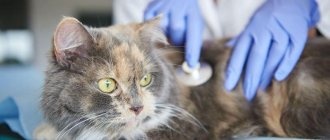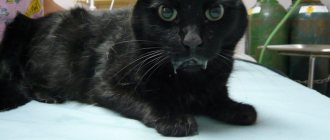Cats, like humans, sometimes experience tremors - trembling of the whole body and limbs caused by rhythmic muscle contraction. A single tremor may not cause serious concern to the owner, but it is worth knowing the possible causes of this phenomenon in order to avoid the development of dangerous pathologies. In this article, we looked at the main reasons why cats can tremble: we will tell you when trembling is harmless, and when it is an alarming symptom and indicates the development of complications. You will also learn the basic methods of diagnosis and symptomatic treatment.
Cold
Animals can freeze and are no less susceptible to hypothermia than people, so cold is the most common factor that causes tremors in a cat’s body. In this case, you can notice a slight trembling simply by placing your hand on the animal’s body. Larger tremors are visible to the naked eye.
Why does the kitten tremble and shake after water treatments? Kittens are more sensitive to high humidity and low temperatures; the thermoregulation system in their body has not yet been formed. This reaction is also characteristic of adult cats: cats tolerate low temperatures well, but can freeze and react poorly to high humidity.
IMPORTANT: monitor the room heating level. Take care of your pet by insulating its bed, use special clothing for animals.
Warmth is an important condition for a pet’s comfortable existence.
Shivering from the cold is not a cause for great concern, but prolonged exposure to low temperatures can weaken the animal and cause illness.
Fear
At the sight of danger, repeated tremors may run through the animal’s body. Such a reaction can be caused by instincts: self-preservation, if a cat sees a potentially dangerous animal - a dog. A new person, unfamiliar objects, an unusual environment - anything that has not yet been explored can frighten a pet.
A cat's tail raised is a sure sign of fear.
IMPORTANT: allow your pet to adapt! Do not grab him in your arms or make sudden movements - a frightened animal may react negatively.
You can especially clearly observe this phenomenon in small kittens when they are picked up: a small child may flinch, he will be frightened by the touch of someone other than his mother.
Be affectionate and attentive, let the kitten gradually get used to you
The most common stress for pets is transportation: moving, traveling to the veterinarian. Both situations are accompanied by strong impressions of unfamiliar places and people. In the case of a clinic, there may be a large crowd of strangers, which can seriously frighten the cat. Try to make the transportation conditions easier by periodically contacting your pet, talking to him, encouraging him and giving him treats, showing maximum attention and care, and letting him feel that you are nearby.
When to contact a veterinarian
Why is my dog shaking, lethargic and panting?
A visit to a specialist is justified by the question of why a domestic cat’s body and paws periodically tremble. Veterinarians advise coming to the clinic if the following signs occur:
- aggressiveness;
- lethargy and apathy;
- frequent bowel movements;
- bouts of vomiting;
- intestinal disorders with constipation.
Veterinarian appointment
If the cat continues to freeze for no apparent reason and tries to lie down, then refusal of treatment can lead to serious consequences, even death.
The cat is happy
Reason for joy is another reason for trembling in cats. Having met the owner after a long separation, a happy pet can be under the influence of the “hormone of happiness” for a long time, which is released into the animal’s blood.
Felines have a strong bond with their owners.
The fact is that cats are sensitive animals, capable of developing strong and long-lasting attachments to their beloved owner. Many of them experience separation painfully, which can cause a strong emotional outburst when they meet. Thus, positive emotions can also cause tremors in an animal.
IMPORTANT: if your pet has a hard time with long separation, try to minimize stress for the animal and do not leave it alone for a long time.
First aid: owner actions
In such situations, a person’s self-control plays an important role. Timely measures taken will help save the life of a pet:
- During an attack, the cat must be carefully laid on a flat surface, which is covered with oilcloth or rags. At the same time, you cannot forcibly hold it, so as not to provoke unnecessary stress. You should not unclench your jaws, so as not to injure the animal.
During an attack, it is recommended to administer an anticonvulsant and analgesic to your pet. They do this by injection, and not by mouth: convulsions that seize the muscles of the larynx will not allow the cat to swallow the medicine, and it will simply choke.- A light massage will help ease the spasm. It is carried out on areas of the body affected by convulsions.
Even a small isolated attack is already a reason to urgently take your pet for examination. Convulsive muscle contractions don’t just happen. There needs to be a reason for this, and each of them is dangerous.
Sexual arousal
The mating season is another reason for small tremors in cats. At the moment of sexual heat, a surge of hormones occurs in animals and small tremors are especially noticeable when they see a partner. Cats during heat are very sensitive to odors, their senses are heightened, and they may behave unusually and restlessly. This reaction is healthy and characteristic of animals during the “rutting” period. This problem is solved by surgical intervention to remove the reproductive function.
The mating season is distinguished by “vivid” manifestations in the behavior of cats and cats
IMPORTANT: puberty in animals occurs gradually and hormones are released into the blood in small doses. Normally, puberty does not cause tremors!
Other reasons
Why does a cat tremble and shudder when at rest? In this case, biological processes continue to operate in the animal’s body. You can observe how a cat trembles when falling asleep and during sleep: periodic tremor of the paws or shuddering of the whole body indicates that the animal is as relaxed as possible. Your pet may have restless dreams, as if you took away a juicy sausage from him or a small rodent slipped right out from under his paws. It is also possible that the pet simply truly enjoys the rest and when waking up, the trembling completely disappears.
There is no need to worry if there are no other symptoms: the animal will wake up and everything will be fine
IMPORTANT: do not try to wake up the animal abruptly; the pet may not immediately understand that the owner is in front of it and show aggression.
Trembling as a warning sign
Unfortunately, trembling can be a symptom of the development of many pathologies. Among them the most common:
– a lack of B vitamins and calcium can make a cat passive and indifferent; reconsider the diet if the pet is inactive, indifferent to treats and favorite games;
– infection with parasites (worms, fleas, ticks) is a common cause of intense trembling in animals;
– diseases of the musculoskeletal system (rinotracheitis) are manifested by frequent twitching of the limbs;
– severe trembling and convulsions may occur as a result of the development of meningitis, rabies, encephalitis, borreliosis;
– pneumonia manifests itself through severe chills, coughing, sneezing, and discharge from the sinuses;
– plugs in the ears, otitis media provoke twitching of the head;
Accompanying symptoms and restless behavior are a reason to consult a doctor
– damage by toxic substances causes slight trembling, which is gradually replaced by convulsions;
– severe trembling of the whole body and head may indicate internal injuries;
– lethargy, lack of appetite and trembling may be a consequence of the development of infection in the animal’s body;
– epilepsy is a dangerous disease that causes twitching of the whole body, increased salivation, decreased appetite, and “glassy” eyes;
– kidney dysfunction often manifests itself through trembling, which, if ignored, can cause urolithiasis;
With brain damage
Pathologies affecting this organ are the most dangerous. Defeat can be caused by both external factors and internal processes.
Causes
| Disease | Peculiarities |
| Tick-borne encephalitis | When an ixoid tick bites, an infection enters the cat's body with the insect's saliva, causing the disease. Characteristic signs other than seizures:
|
| Hypoxia | Oxygen starvation can occur for a number of reasons, but in any case it leads to damage to brain tissue. At first, the symptoms are mild, and the seizures are so short-lived that the owner may simply not notice them. As the pathology develops, the number of convulsions and their duration increase. Hypoxia can be suspected by suddenly appearing shortness of breath, fainting, or cyanosis of the mucous membranes. |
| Rabies | Not just dangerous - a fatal disease caused by Babes Negri bodies. The animal's hind legs twitch first, then its limbs become paralyzed. While the cat is able to move, it shows strong aggression. The disease develops rapidly. Spasms pass from the body muscles to the respiratory muscles, and the animal dies from suffocation |
| Tumors | The initial stage of oncology has no obvious symptoms. They will appear when the tumor, growing, begins to put pressure on important areas of the brain. The animal's behavior changes: the cat becomes aggressive, loses orientation - constantly bumps into walls, objects, and monotonously circles in one place. The disease is often accompanied by convulsive seizures |
| Hydrocephalus | The cause is disruption of the outflow of fluid from the brain. The pathology is congenital and can be detected at an early stage. A kitten suffering from hydrocephalus has a larger skull volume than healthy babies, and it lags behind its brothers in development. The disease manifests itself as clonic convulsions, the first signs of which can be noticed at 2 months of age. The rapid development of pathology leads to death |
| Hematomas, injuries | Damage to the skull is accompanied by profuse vomiting. With severe injuries, loss of consciousness, paralysis of a group of muscles and twitching of those that hold the eyeballs are possible. |
Even an unbalanced diet, which provokes the development of vitamin deficiency, can cause brain damage.
In particular, this concerns vitamin B1 (thiamine), which is necessary for the smooth functioning of systems. The initial stage is manifested by trembling of the limbs; with severe deficiency, convulsions are observed.
Diagnostic measures
Having noted involuntary trembling in an animal, the first step is to distinguish external causes (hypothermia, overheating, fear, sexual arousal) from internal ones, eliminating previous events that could cause serious pathology. When visiting a veterinary clinic, tell the doctor about any potentially dangerous situations in the past that make you even slightly suspicious. Pay special attention to:
– number of repetitions and duration of trembling;
– presence of other symptoms;
– dates of the last deworming and vaccination;
IMPORTANT: If you have alarming symptoms, analyze the events that could cause the tremor and share the information with your doctor.
The examination will help identify disorders in the body.
The following will help to establish an accurate diagnosis:
– complete blood count, stool and urine analysis;
– radiography;
– MRI or CT scan of the brain;
– electromyography – to assess the bioelectrical activity of muscles;
– myelography – for diagnosing spinal cord tumors;
– puncture of cerebrospinal fluid to detect encephalitis;
Diagnostics
If your pet is suspected of having a disease, it is necessary to conduct an examination, which includes donating blood for tests.
The animal must be urgently shown to a doctor if trembling constantly bothers you, the cat is lethargic, lies down all the time, eats poorly or generally refuses to take food and water. At the initial appointment, the veterinarian will examine the pet, ask the owner about disturbing accompanying symptoms, and collect other important information. The following research methods will help determine an accurate diagnosis:
- general blood test, urine test;
- biochemistry;
- coprogram;
- microbiological examination of a smear from mucous membranes;
- ECG;
- radiography;
- Ultrasound of internal organs.
Treatment according to symptoms
Tremor caused by external manifestations does not require therapeutic intervention; it is enough to minimize the factors that cause the pet to tremble. If the cause of trembling is:
– hypothermia : warm the animal, dry the fur (if necessary), stroke it, give a light massage of the paws and body;
– overheating : use a cold compress, provide your pet with plenty of water:
– stress : calm your pet, let him lie down for a while and unobtrusively stroke him, give him a treat and protect him from the factor that causes fear;
– sexual heat : be attentive to the condition of your pet, consult a doctor about the possibility of using drugs that reduce sexual activity;
– sleep : if the cat trembles all over at rest, wait for the pet to wake up, or, as a last resort, wake him up;
Lack of stress eliminates the occurrence of tremors in pets
If you notice regular tremor of the whole body and limbs in your pet, you should contact a veterinarian and undergo a full clinical examination at a veterinary clinic. This will help to quickly identify the source of pathology and prescribe the necessary treatment.
In case of improper nutrition and care, the doctor will give the necessary recommendations that will further help eliminate the occurrence of tremor.
Treatment includes the prescription of medications - sedatives and anthelmintics, symptomatic and antimicrobial therapy. The presence of neoplasms, pathologies and disorders of the nervous and musculoskeletal system are indications for surgical intervention. In the future, the animal will need additional examination and careful care.
The process of recovery from anesthesia
The cat is coughing: why it wheezes, the reasons, as if it was choking
Symptoms that occur after surgery include:
- constant attempts to fall asleep in any position;
- lack of coordination; when trying to stand up, the pet twitches and falls on its side;
- hard breath;
- searching for a dark place;
- involuntary release of urine and feces;
- salivation.
The pupil is dilated, without reaction to light, the anomaly is present for 1-2 days. The animal fully recovers after anesthesia within 2-3 days.
Expert advice
Domestic cats and cats have inherited excellent health from their distant ancestors: they are hardy, easily adaptable and perfectly adapted to different living conditions. The reasons for trembling in cats are varied. It is important to ensure that your pet does not become overcooled or overheated and that it eats regularly and nutritiously. It is important to carry out timely deworming and vaccination measures, which significantly reduces the risk of developing dangerous diseases.
Paying attention to your cat's health will protect you from unwanted consequences.
If your pet begins to tremble and this phenomenon begins to appear more and more often, take maximum care of your pet and visit a veterinary clinic to avoid the development of complications and chronic pathologies.











